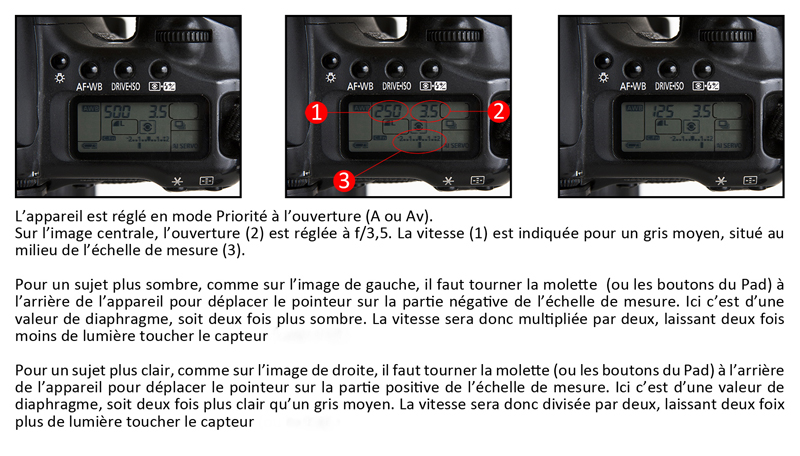Given that your camera's light sensor reduces the dominant brightness in the scene to a "middle grey", how can you tell your camera that the subject is darker or lighter? In A, S or M mode, your camera offers a precise way to do so using the exposure scale. By moving the cursor up or down on the scale, you can specify that the scene should be brighter or darker.
Handy tips
- How you move the cursor depends on the selected mode.
- Each number up or down on the scale means twice as much (or less) light.
1. A (Aperture Priority) mode
Semi-automatic mode: you control the diaphragm aperture and exposure; the camera calculates the shutter speed required to obtain the aforementioned "middle grey".
- The further towards +1... +2, etc that that you move the cursor, the more overexposed, i.e. brighter, the image will be, and the slower the shutter speed set by your camera.
- The further towards – 1... – 2, the more underexposed, i.e. darker, the picture will be, and hence the higher the shutter speed.
Note: this mode gives you priority control over the depth of field, which is extremely useful when you wish to make a subject stand out from their surroundings, especially for portraits, or indeed landscapes.
2. S (Shutter Priority) mode
Semi-automatic mode: you control the shutter speed. As in A mode, you move the cursor up and down the exposure scale, allowing you to overexpose or underexpose the image: the camera sets a smaller or larger aperture accordingly.
- Crucial when trying to freeze a moving subject or produce a controlled blur effect.

3. M (Manual) mode
Using the exposure scale for total aperture and speed control By changing one or the other of the values you will see the indicator moving on the scale which will show whether the area being measured will be darker than medium grey (going towards -) or lighter (towards +) .
4. Exposure compensation parameters for different subjects
The following table is a guide to the exposure settings to use for ISO 100.
|
Conditions |
Camera settings |
Notes |
|
Skier on a brightly lit slope |
f/5.6 at 1/1000 |
High shutter speed to freeze the movement |
|
White sandy beach, snowy landscape |
f/16 at 1/125 |
Small aperture, giving a large depth of field |
|
Children running over white sand |
f/8 at 1/500 |
High shutter speed to freeze the movement |
|
Outdoor amateurs ports in sunny weather |
f/5.6 at 1/250 |
If the shutter speed is too low to freeze the movement, try with f/4 at 1/500 |
|
The moon at night |
f/8 at 1/250 |
|
|
People outdoors in sunny weather |
f/8 at 1/125 |
|
|
People in overcast weather |
f/4 at 1/125 |
A moderate burst of flash may improve the result |
|
People taken against the light |
f/5.6 at 1/125 |
A moderate burst of flash may improve the result |
|
Lit street at night |
f/2.8 at 1/15 |
|
|
Exposure compensation (A and S modes) |
||
|
Person against a white wall |
+ 1.5 EV on the scale |
The larger the subject appears in shot, the less compensation required. |
|
Close-up portrait of a face, white skin. |
+ 1 EV |
|
|
Close-up portrait of a face, coloured skin. |
0-0.5 EV |
With lighter non-white skin, stick to +0.5 EV |
|
Close-up portrait of a face, coloured skin. |
-0.5 to -1 EV |
|
Recommended product:
Digital Everyday Matt
See also :
Photography
Photography: ISO sensitivity
